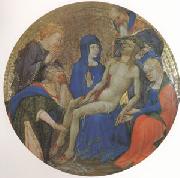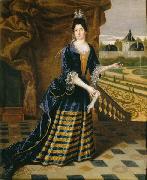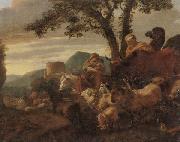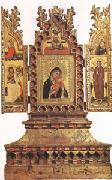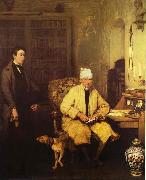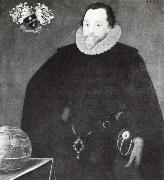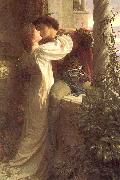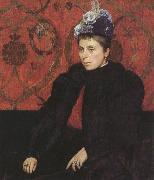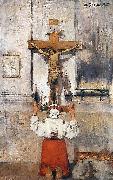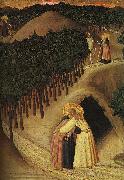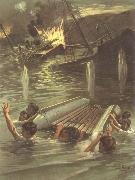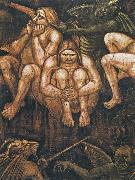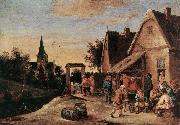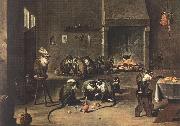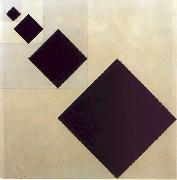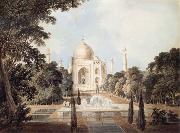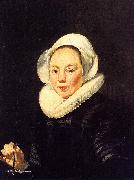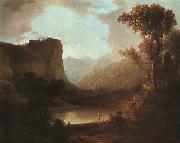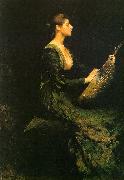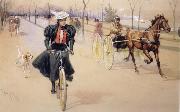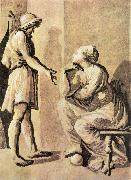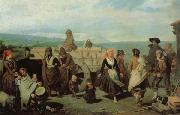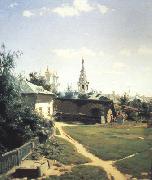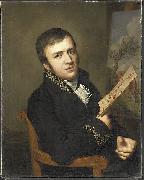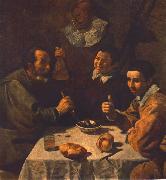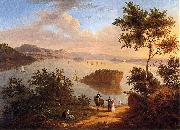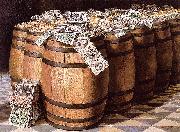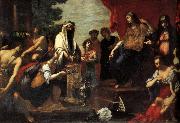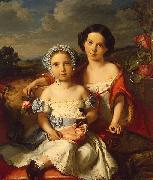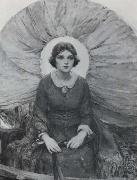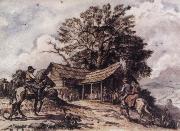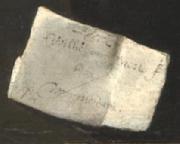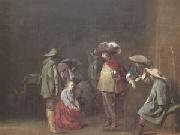|
|
|
|
|
|
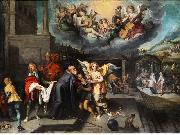 |
Simon de Vos
|
|
Simon de Vos (Antwerp, 20 October 1603-15 October 1676, Antwerp) was a Flemish Baroque painter of genre and cabinet pictures.
De Vos studied with Cornelis de Vos (1603-76), to whom he is not related, from 1615 until 1620. In 1620 he joined Antwerp's guild of St. Luke, and then he probably travelled to Rome where he came under the influence of the "low-life" genre paintings of the Bentvueghels and the bambocciate. A Caravaggesque influence, by way of the German painter Johann Liss active in Italy during the 1620s is discernible in De Vos's paintings from this time on. In contrast to the earlier "low-life" paintings, works from the late 1620s until around 1640, which were made after returning to Antwerp, are mostly small "merry company" and courtly genre scenes reminiscent of contemporary Dutch painters Dirck Hals and Pieter Codde. After 1640, De Vos turned away from genre scenes altogether and painted mostly small cabinet paintings of history subjects, influenced stylistically at first by Peter Paul Rubens and then increasingly by Anthony van Dyck. Examples include The Beheading of St. Paul (1648) in the Royal Museum of Fine Arts, Antwerp.
He married Catharina van Utrecht, the sister of Adriaen van Utrecht, in 1628. |
|
|
|
|
|
|
|
|
|
|
|
|
|
|
|
|
|
|
|
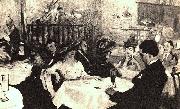 |
stefan Dimitrescu
|
|
(January 18, 1886 - May 22, 1933) was a Romanian Post-impressionist painter and draftsman.
Born in Huşi into a modest family, he completed his primary and secondary studies in his hometown. In 1902, deciding to follow his passion for music, he left for Iaşi, where he took cello classes at the Iaşi Conservatory.
In summer of 1903, Dimitrescu entered the National School of Fine Arts in the city, studying in the same class as Nicolae Tonitza; the two studied under Gheorghe Popovici and Emanoil Bardasare. After graduation, Dimitrescu painted murals for the Orthodox churches in Agăş and Asău (Bacău County). |
|
 |
Stefano da Verona
|
|
Stefano da Verona. Dating to 1434, it is currently housed in the Pinacoteca di Brera of Milan, northern Italy.
|
|
|
|
|
|
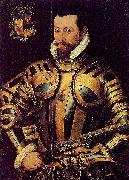 |
Steven van der Meulen
|
|
(b. eAntwerp - d. London, e1563-64) was a Dutch artist active c. 1543-1564. He gained prominence in England in the first decade of the reign of Elizabeth I as one of many Flemish artists active at the Tudor court. He is best known for the "Barrington Park" portrait type of Elizabeth I and for three-quarter length portraits of members of the English court in the first half of the 1560s. A recently discovered will indicates that he died in London between October 1563 and January 1564.
|
|
|
|
|
|
|
|
|
|
|
|
|
|
|
|
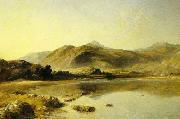 |
Thomas Danby
|
|
(c. 1818 - 25 March 1886) was an English landscape painter.
Danby was born, it is thought, in Bristol in south-west England, the younger son of Francis Danby (1793-1861). He had an elder brother, James Francis Danby (1816-75) who also became a landscape painter. Thomas went with his father to Europe in 1829, living for a time in Paris where he was able to earn a living by copying pictures at the Louvre in Paris. He thus became an earnest admireer and "student" of Claude Lorrain, whose aerial effects he sought to imitate.
Returning to England about the same time as his father, he first exhibited at the British Institution in 1841, and afterwards frequently at the Royal Academy from 1843. He was a friend of Paul Falconer Poole, with whom he shared a house in Hampstead in 1843, and imbibed not a little of his romantic feeling for nature. From 1855 to his death, Danby resided in or near Hampstead in north London..
The subjects of his landscapes were usually taken from Welsh scenery, especially the old county of Merioneth; his pictures for the most part were not ideal compositions (unlike his father's work) but actual scenes pervaded with a true romantic spirit. "He was always trying" says the writer of his obituary in The Times newspaper, "to render his inner heart's feeling of a beautiful view rather than the local facts received on the retina."
He came, it is said, within one vote of election as an Associate of the Royal Academy (ARA) but, failing eventually to attain Academy honours, he devoted himself in his latter years chiefly to watercolour painting. He became a member of the Royal Hibernian Academy in 1860, an associate of the Society of Painters in Watercolours in 1867, and a full member of the latter in 1870; until his death his contributions were prominent amongst the works at the society's exhibitions.
Danby died of a chest complaint, terminating in dropsy on 25 March 1886. He had been twice married, and had 2 daughters and a son from the second marriage.
|
|
|
|
|
|
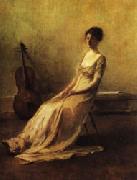 |
Thomas Dewing
|
|
(May 4, 1851 C November 5, 1938) was an American painter working at the turn of the 20th century. He was born in Newton Lower Falls, Massachusetts. He studied at the Acad??mie Julian in Paris, and later settled into a studio in New York City. He married Maria Oakey Dewing, an accomplished painter with extensive formal art training and familial links with the art world.
He is best known for his tonalist paintings, a sub-genre of American art that was rooted in English Aestheticism. Dewing's preferred vehicle of artistic expression is the female figure. Often seated playing instruments, writing letters, or engaged in other impassive actions and situated in gauzy, dreamy interiors, the figures remain remote and distant to the viewer. These scenes are infused with a color that pervades the entire picture, setting tone and mood. The ethereal delicacy and subtle color harmonies of Dewing's paintings have not met with universal approval: some feminist critics have lambasted Dewing's work as being misogynistic; he rarely painted anything other than the female figure, vacant of expression, languishing in sumptuous clothing.
Tonalism quickly came to be considered outdated with the advent of modernism and abstraction in art, though Dewing was successful in his own day. His art was considered extremely elegant, and has undergone a subtle revival in the last 10 years or so.
Dewing was a member of the Ten American Painters, a group of American Impressionists who seceded from the Society of American Artists in 1897. |
|
|
|
|
|
|
|
|
|
|
|
|
|
|
|
|
|
|
|
|
|
|
|
|
|
|
|
|
|
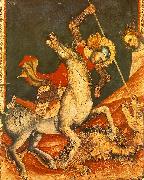 |
VITALE DA BOLOGNA
|
|
Italian Gothic Era Painter ,
b. 1289/1309, Bologna, d. 1359/69, Bologna |
|
|
|
|
|
|
|
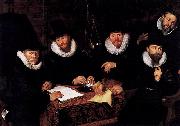 |
Werner van den Valckert
|
|
Though he was born in Amsterdam, he became a member of the Guild of St. Luke in the Hague between 1600 - 1605. By 1614 he had moved to Amsterdam, because his daughter was baptized there. His earliest dated etchings are from 1612. His surviving paintings are historical allegories and portraits. He also made a prestigious schutterstuk, which features the Amsterdam burgermeester Albert Burgh.
According to Houbraken, he was a student of Hendrik Goltzius. He painted a series of 4 paintings showing a doctor as angel, Christ, a man, and the devil; these were all based on engravings by Goltzius. These paintings are now in the possession of the Boerhaave Museum, which has other similar series on display. |
|
|
|
|
|
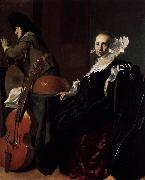 |
Willem Cornelisz. Duyster
|
|
(1599-1635) was a Dutch Golden Age painter from Amsterdam.
According to the RKD, his name was taken from his house on the Amsterdam Koningstraat, which was called "De Duystere Werelt", the dim world. He was a pupil of Pieter Codde. He married the sister of the painter Simon Kick (1603-1652), who himself married Willem's sister. |
|







